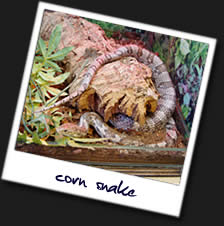www.reptiles-info.co.uk

Snake Healthcare:
Corn snakes are generally a hardy reptile and will rarely suffer from diseases or illnesses providing they are housed and fed correctly. If however you snake does become ill we have offered a few symptoms that can help to diagnose your snake. If any problems persist it is advised that you see you veterinary surgeon immediately.
Shedding Problems:
Your corn snake should usually shed its skin every one or two months this depends on the size and diet of the snake, you will notice when your snake is about to shed its skin as the eyes of the corn snake will turn blue. This will be followed by the snake rubbing itself against another object to roll out of its skin. You should always check the shed skin of the snake to check that it is a complete rthl and the eye caps have also been shed. If a snake has not shed its skin completely this can build up and cause problems for the snake such as preventing blood entering the tail leading to amputation. To help the snake shed its skin it is advised to include a large dish that the snake can soak in which will help to make the skin more pliable and easier to shed.
Regurgitation Problems:
If your corn snake starts to regurgitate its food it is usually because the temperature in the snakes housing is too low or the snake has started the shedding process. Try improving the hotspot located in your snakes housing as corn snakes need heat to aid digestion of their food, also clean the tank thoroughly and if the problem persists you should see your vet as soon as possible. You should wait Food may also be regurgitated if it is not of the appropriate size for the snake. For More Information On Feeding Snakes Click Here
Respiratory Problems:
If you notice that your snake is having trouble breathing and is making wheezing noises, runny nose or even sneezing it is likely that your snake has contracted a respiratory related illness. The cause of this can be from incorrect temperature within the snakes housing in order to stop the disease worsening you should immediately raise the temperature of you snakes housing to around 80 degrees Fahrenheit in order to help cure the snake. If the problem persists after two days visit your vet as soon as possible.
Mites and Ticks:
You can diagnose whether or not you pet corn snake has mites or ticks by looking closely at the skin of the snake, mites can be identified as fast moving dots whereas ticks are much larger and are usually found in between the scales of the skin. The easiest way in which to remove mites from your snake is to give the snake a warm bath that involves placing your corn snake in a bath of warm water around two inches deep so that the mites will drown and should be visible in the water. After this process you must remove everything from the snakes housing then clean and disinfect the whole area before putting the snake back in its home. You can remove ticks from the snake by rubbing your snake in petroleum jelly covering the whole body this will prompt the ticks to leave the skin of the snake and with tweezers you can pick away the ticks, however you must be careful not to injure the snake whilst doing this. You can also help to prevent ticks by disinfecting every item you place in the snake's tank such as rocks and branches. All new snakes should be quarantined before being housed in with your current vivarium.
Burns:
Skin damage and the burning of your snake's skin can be a common and some tim i fatal injury to your corn snake that is often caused by bulbs being to close and easily exposed within your snake's housing. This can be prevented by making sure your bulb is the correct distance away form the snake and installing a thermostat within the housing would also be an excellent way to help prevent overheating within the snake's cage. For More Information On Correct Reptile Lighting Click Here
Blistering:
Blister disease is a common problem with snakes kept in vivariums and is often caused by dirty or high humidity environments. To diagnose this problem you will often notice the belly of the snake will turn a yellow/brown colour with blisters developing on the snake, if this has happened it is advised that you clean your tank thoroughly by removing the substrate and sterilising the whole of the snake's housing. You should then bath your snake in water and add hydrogen peroxide to the infected parts of the snakes body; you should then leave your snake in a hospital tank in order for it to recover. If the problems persist after this treatment visit your vet immediately.
Snake Pages






